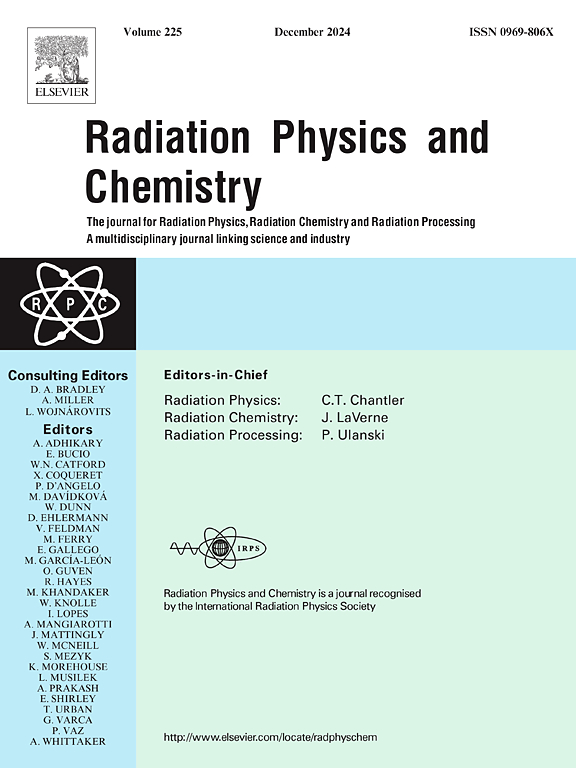镍、钴、铜、锌掺杂WO3薄膜中Kβ/Kα x射线强度比的测量
IF 2.8
3区 物理与天体物理
Q3 CHEMISTRY, PHYSICAL
引用次数: 0
摘要
本文利用x射线荧光技术(XRF)研究了喷雾热解法掺杂10 - 20% Ni, Co, Cu和Zn过渡金属的氧化钨(WO3)薄膜的Kβ/Kα x射线强度比。用A241Am放射源发射强度为5 Ci (~ 185 GBq)、能量为59.543 keV的射线激发样品。用分辨率为180 eV, 5.96 keV的HPGe探测器对薄膜发射的特征x射线进行了计数。采用XRD分析研究了过渡金属掺杂对WO3薄膜晶体结构的影响,并用扫描电子显微镜(SEM)和能量色散x射线能谱仪(EDX)研究了过渡金属掺杂对WO3薄膜形貌的影响。观察到,随着过渡金属掺杂浓度的增加,WO3薄膜样品的Kβ/Kα x射线强度比增大。将Kβ/Kα x射线强度比与纯Ni, Co, Cu和Zn元素的理论和实验研究结果进行了比较。XRD分析表明,未掺杂的氧化钨和掺杂镍、钴、铜的薄膜具有非晶结构,而掺杂锌的氧化钨薄膜具有单斜晶结构。本文章由计算机程序翻译,如有差异,请以英文原文为准。
Measurement of Kβ/Kα X-ray intensity ratios in nickel, cobalt, copper and zinc doped WO3 thin films
In this study, the Kβ/Kα X-ray intensity ratios of tungsten oxide (WO3) thin films doped with 10–20 % Ni, Co, Cu and Zn transition metals by spray pyrolysis method were investigated by X-ray fluorescence technique (XRF). A241Am radioactive source emitting a beam with an intensity of 5 Ci (∼185 GBq) and an energy of 59.543 keV was used to excite the samples. A HPGe detector with a resolution of 180 eV at 5.96 keV was used to count the characteristic X-rays emitted from the thin films. The impact of doping transition metals on the crystal structure of WO3 thin films was investigated using XRD analysis, while their morphological properties were examined via scanning electron microscopy (SEM) coupled with energy-dispersive X-ray spectroscopy (EDX). It was observed that the Kβ/Kα X-ray intensity ratios increased in accordance with the concentrations of transition metals doped into the WO3 thin film samples. The values obtained from the Kβ/Kα X-ray intensity ratios were compared with the findings of theoretical and experimental studies for pure Ni, Co, Cu and Zn elements. XRD analysis revealed that undoped tungsten oxide and nickel, cobalt and copper doped thin films have an amorphous structure, while zinc doped tungsten oxide thin film has a monoclinic structure.
求助全文
通过发布文献求助,成功后即可免费获取论文全文。
去求助
来源期刊

Radiation Physics and Chemistry
化学-核科学技术
CiteScore
5.60
自引率
17.20%
发文量
574
审稿时长
12 weeks
期刊介绍:
Radiation Physics and Chemistry is a multidisciplinary journal that provides a medium for publication of substantial and original papers, reviews, and short communications which focus on research and developments involving ionizing radiation in radiation physics, radiation chemistry and radiation processing.
The journal aims to publish papers with significance to an international audience, containing substantial novelty and scientific impact. The Editors reserve the rights to reject, with or without external review, papers that do not meet these criteria. This could include papers that are very similar to previous publications, only with changed target substrates, employed materials, analyzed sites and experimental methods, report results without presenting new insights and/or hypothesis testing, or do not focus on the radiation effects.
 求助内容:
求助内容: 应助结果提醒方式:
应助结果提醒方式:


